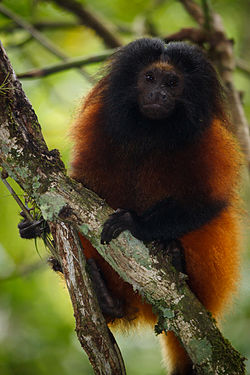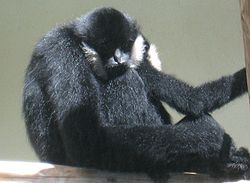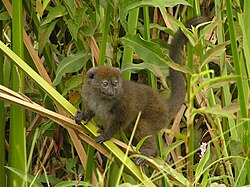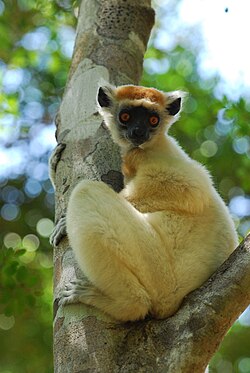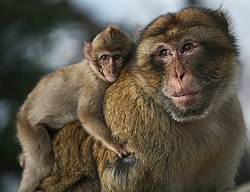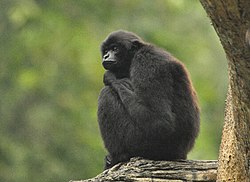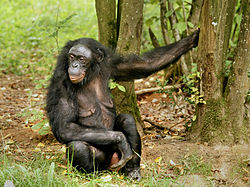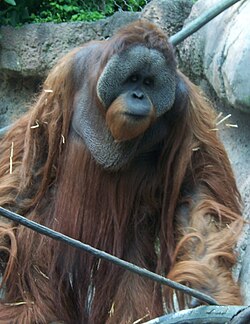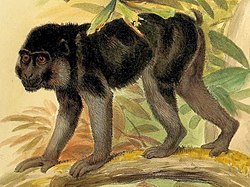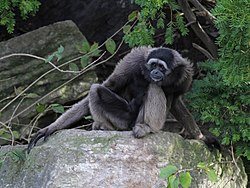Common name Binomial name Population Status Trend Notes Image Hainan black crested gibbon Nomascus hainanus 20–50 [ 1] CR [ 1] [ 1] Population was estimated at over 2,000 in the late 1950s. [ 1] Eastern black crested gibbon Nomascus nasutus 45–47 [ 2] CR [ 2] [ 2] Previously thought to be possibly extinct. Numbers may be higher. [ 2] Cat Ba langur Trachypithecus poliocephalus 51–54 [ 3] CR [ 3] [ 3] Popa langur Trachypithecus popa 135–176 [ 4] CR [ 4] [ 4] Estimate for mature individuals. [ 4] Raffles' banded langur Presbytis femoralis 200–250 [ 5] CR [ 5] [ 5] Sarawak surili Presbytis chrysomelas 200–500 [ 6] CR [ 6] [ 6] Perrier's sifaka Propithecus perrieri 230 [ 7] CR [ 7] [ 7] One of the 25 most endangered primates. [ 7] Delacour's langur Trachypithecus delacouri 234–275 [ 8] CR [ 8] [ 8] The population of the species has radically decreased over the past decade. [ 8] Silky sifaka Propithecus candidus 250 [ 9] CR [ 9] [ 9] Estimate is believed to be a maximum. [ 9] Tonkin snub-nosed monkey Rhinopithecus avunculus 250 [ 10] CR [ 10] [ 10] Barbara Brown's titi Callicebus barbarabrownae 260 [ 11] CR [ 11] [ 11] Minimum estimation. [ 11] Myanmar snub-nosed monkey Rhinopithecus strykeri 260–330 [ 12] CR [ 12] [ 12] Mentawai langur Presbytis potenziani 300–1,200 [ 13] CR [ 13] [ 13] Superagui lion tamarin Leontopithecus caissara 400 [ 14] CR [ 14] [ 14] Maximum estimate. [ 14] Blond capuchin Cebus flavius 500 EN [ 15] Greater bamboo lemur Prolemur simus 500 [ 16] CR Kashmir gray langur Semnopithecus ajax 500 [ 17] EN [ 17] [ 17] Maximum estimate; 250 mature. [ 17] Coimbra Filho's titi Callicebus coimbrai 500–1,000 [ 18] EN [ 18] [ 18] Gray-shanked douc Pygathrix cinerea 550–700 [ 19] CR [ 19] [ 19] Arunachal macaque Macaca munzala 569 [ 20] EN [ 20] [ 20] While one source gives a minimum estimate of 569, another claims adult species number less than 250. [ 20] White-headed langur Trachypithecus leucocephalus 600 [ 21] CR [ 21] [ 21] Gray snub-nosed monkey Rhinopithecus brelichi 750 [ 22] EN [ 22] [ 22] Northern muriqui Brachyteles hypoxanthus 855 [ 23] CR [ 23] [ 23] Minimum estimate. [ 23] Black lion tamarin Leontopithecus chrysopygus 1,000 [ 24] EN [ 24] [ 24] Tana River mangabey Cercocebus galeritus 1,000–1,200 [ 25] EN [ 25] [ 25] Kipunji Rungwecebus kipunji 1,117 [ 26] EN [ 26] [ 26] Sanje mangabey Cercocebus sanjei 1,300 [ 27] EN [ 27] [ 27] Estimate is likely a maximum. [ 27] Southern muriqui Brachyteles arachnoides 1,300 [ 28] EN [ 28] [ 28] Black crested gibbon Nomascus concolor 1,300–2,000 [ 29] CR [ 29] [ 29] Siau Island tarsier Tarsius tumpara 1,358–12,470 [ 30] CR [ 30] [ 30] Amongst the world's top 25 most endangered primates. [ 30] Golden bamboo lemur Hapalemur aureus 1,479 [ 31] CR [ 31] [ 31] [ 31] Red slender loris Loris tardigradus 1,500 [ 32] EN [ 32] [ 32] Sangihe tarsier Tarsius sangirensis 1,505–2,795 [ 33] EN [ 33] [ 33] Population estimates are considered inconclusive. [ 33] Zanzibar red colobus Procolobus kirkii 2,000 [ 34] EN [ 34] [ 34] Maximum estimate. [ 34] Black snub-nosed monkey Rhinopithecus bieti 2,000 [ 35] EN [ 35] [ 35] Maximum estimate; less than 1,000 mature organisms. [ 35] François' langur Trachypithecus francoisi 2,000–2,100 [ 36] EN [ 36] [ 36] Estimate for mature individuals. [ 36] Pagai Island macaque Macaca pagensis 2,100–3,700 [ 37] CR [ 37] [ 37] Numbered 15,000 in 1980. [ 37] Indochinese gray langur Trachypithecus crepusculus 2,400–2,500 [ 38] EN [ 38] [ 38] Estimate for mature individuals. [ 38] Lac Alaotra bamboo lemur Hapalemur alaotrensis 2,500 [ 39] CR [ 39] [ 39] Estimates were for 2002 and showed a decline of over 50% in under ten years. [ 39] Moor macaque Macaca maura 3,000–5,000 [ 40] EN [ 40] [ 40] Golden lion tamarin Leontopithecus rosalia 3,200 [ 41] EN [ 41] [ 41] Minimum estimate; wild only. [ 41] In addition to these, there are about 490 golden lion tamarins in 150 zoos around the world. [ 42] Lion-tailed macaque Macaca silenus 4,000 [ 43] EN [ 43] [ 43] Estimate is a maximum. [ 43] Silvery gibbon Hylobates moloch 4,000–4,500 [ 44] EN [ 44] [ 44] Javan surili Presbytis comata 5,000–12,000 [ 45] VU [ 45] [ 45] Javan fuscous leaf monkey Presbytis fredericae 5,000–17,000 [ 46] VU [ 46] [ 46] Gee's golden langur Trachypithecus geei 6,000–6,500 [ 47] EN [ 47] [ 47] Estimate is for mature individuals. [ 47] Eastern gorilla Gorilla beringei 5,880 [ 33] CR [ 33] [ 33] Approximately 5,000 eastern lowland gorillas (G. b. graueri ) [ 33] and 880 mountain gorillas (G. b. beringei ). [ 48] Cotton-top tamarin Saguinus oedipus 6,000 [ 49] CR [ 49] [ 49] Estimate for mature organisms is 2,000. [ 49] Golden-crowned sifaka Propithecus tattersalli 6,000–10,000 [ 50] CR [ 50] [ 50] Golden-headed lion tamarin Leontopithecus chrysomelas 6,000–15,000 [ 51] EN [ 51] [ 51] Muna-buton macaque Macaca brunnescens 6,221–18,435 [ 52] VU [ 52] [ 52] Estimate is from 2007. [ 52] Pig-tailed langur Simias concolor 6,700–17,300 [ 53] EN [ 53] [ 53] Down from an estimated 26,000 in 1980. [ 53] Gray-headed lemur Eulemur cinereiceps 7,265 [ 54] CR [ 54] [ 54] Maximum population estimate is 7,265±2,268. [ 54] Sumatran orangutan Pongo abelii 7,300 [ 55] CR [ 55] [ 55] Madame Berthe's mouse lemur Microcebus berthae 8,000 [ 56] EN [ 56] [ 56] Estimate is a maximum. [ 56] Golden snub-nosed monkey Rhinopithecus roxellana 8,000-15,000 [ 57] EN [ 57] [ 57] Natuna Island surili Presbytis natunae 10,000 [ 58] VU [ 58] [ 58] Roosmalens' dwarf marmoset Callibella humilis 10,000 [ 59] VU [ 59] [ 59] Siberut langur Presbytis siberu 11,014–27,439 [ 60] EN [ 60] [ 60] Population is for Siberut National Park. [ 60] Barbary macaque Macaca sylvanus 15,000 [ 61] EN [ 61] [ 61] Population may be underestimated. [ 61] Udzungwa red colobus Procolobus gordonorum 15,400 [ 62] EN [ 62] [ 62] Population may be overestimated. [ 62] Northern giant mouse lemur Mirza zaza 16,500–17,500 [ 63] VU [ 63] [ 63] Siberut macaque Macaca siberu 17,000–30,000 [ 64] VU [ 64] [ 64] Numbered 39,000 in 1980. [ 64] Capped langur Trachypithecus pileatus 18,600 [ 65] VU [ 65] [ 65] Nilgiri langur Trachypithecus johnii 20,000 [ 66] VU [ 66] [ 66] Maximum estimate; mature individuals number less than 10,000. [ 66] Red-eared guenon Cercopithecus erythrotis 20,000 [ 67] VU [ 67] [ 67] Minimum estimate. [ 67] Kloss's gibbon Hylobates klossii 20,000–25,000 [ 68] EN [ 68] [ 68] Bonobo Pan paniscus 29,500–50,000 [ 69] EN [ 69] [ 69] Population may be underestimated. [ 69] Bornean orangutan Pongo pygmaeus 47,000–73,000 [ 70] CR [ 70] [ 70] Heck's macaque Macaca hecki 100,000 [ 71] VU [ 71] [ 71] Little is known about its populations. Estimate is for mature individuals only. [ 71] Japanese macaque Macaca fuscata 114,431 [ 72] LC [ 73] Tonkean macaque Macaca tonkeana 150,000 [ 74] VU [ 74] [ 74] Western gorilla Gorilla gorilla 150,000–250,000 [ 75] CR [ 75] [ 75] Figures are considered an overestimation. [ 75] Chimpanzee Pan troglodytes 172,700–299,700 [ 76] EN [ 76] [ 76] Booted macaque Macaca ochreata 180,000 [ 77] VU [ 77] [ 77] Estimate is from 2001. [ 77] Gelada Theropithecus gelada 200,000 [ 78] LC [ 78] [ 78] Müller's Bornean gibbon Hylobates muelleri 250,000–375,000 [ 79] EN [ 79] [ 79] Crab-eating macaque Macaca fascicularis 3,000,000 [ 80] EN [ 80] [ 80] Latest full estimation was made at the start of the 2000s. [ 80] Senegal bushbaby Galago senegalensis 107,000,000 [ 81] LC [ 82] Rough estimate based on population density and range. Human Homo sapiens 8,140,000,000 [ 83] LC [ 84] [ failed verification ] [ 84] 







